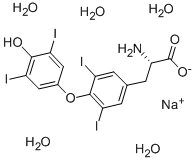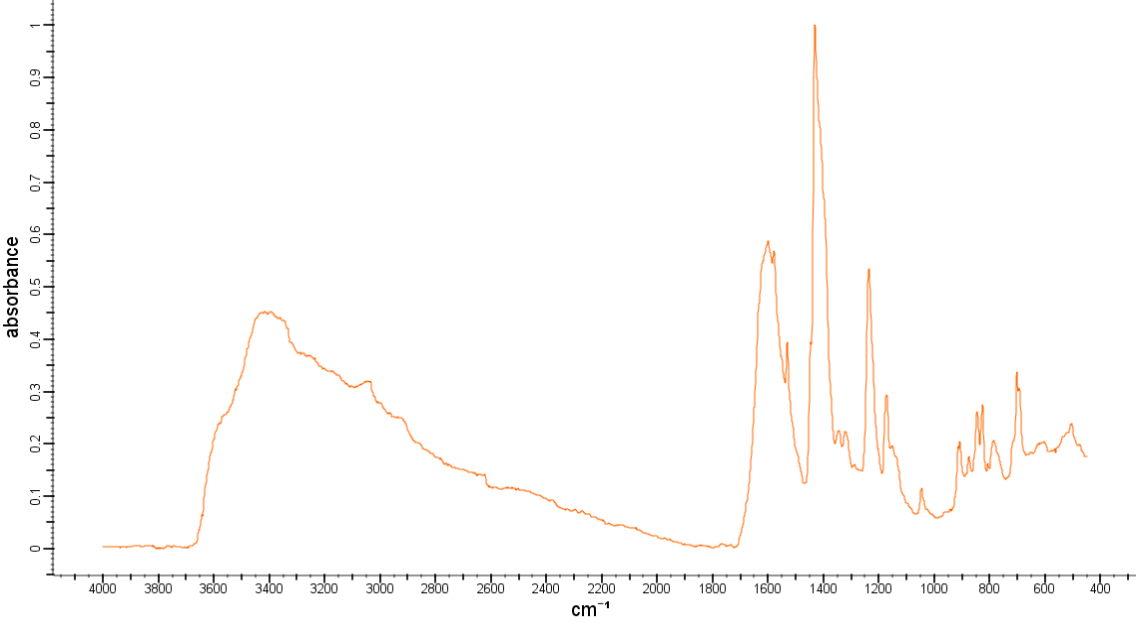Levothyroxine sodium CAS#: 55-03-8(25416-65-3); ChemWhat Code: 52875
| Names & Identifiers | New Literature | Spectral Properties |
| Chemical & Physical Properties | New Patents | Market Information |
| Safety & Hazards | Transportation, Storage & Usage | Approved Manufacturers |
Names & Identifiers
| Product Name | Levothyroxine sodium |
| Molecular Structure |  |
| CAS Registry Number | 55-03-8(25416-65-3) |
| EINECS Number | 200-221-4 |
| Synonyms | Levothyroxine Sodium [INN] [USAN];(2S)-2-Amino-3-[4-(4-hydroxy-3,5-diiodophénoxy)-3,5-diiodophényl]propanoate de sodium [French] [ACD/IUPAC Name];200-221-4 [EINECS]; 216-080-7 [EINECS];[RN];Eltroxin [Trade name];Euthyrox [Trade name];L-3,3′,5,5′-Tetraiodothyronine Sodium Salt;Levaxin [Trade name];Levothroid [Trade name];lévothyroxine sodique [French] [INN];levothyroxinum natricum [Latin] [INN];levotiroxina de sodio [Spanish] [INN];Levotiroxina sodica [Spanish] [INN];Levoxyl [Trade name];L-Thyroxine monosodium salt;L-Thyroxine sodium salt [USP];L-Tyrosine, O- (4-hydroxy-3,5-diiodophenyl)-3,5-diiodo-, monosodium salt;L-Tyrosine, O-(4-hydroxy-3,5-diiodophenyl)-3,5-diiodo-, sodium salt (1:1) [ACD/Index Name];Natrium-(2S)-2-amino-3-[4-(4-hydroxy-3,5-diiodphenoxy)-3,5-diiodphenyl]propanoat [German] [ACD/IUPAC Name];O-(4-Hydroxy-3,5-diiodophenyl)-3,5-diiodo-L-tyrosine Monosodium Salt;Oroxine [Trade name];Sodium (2S)-2-amino-3-[4-(4-hydroxy-3,5-diiodophenoxy)-3,5-diiodophenyl]propanoate [ACD/IUPAC Name];Sodium Levothyroxine;Sodium l-thyroxin;SODIUM L-THYROXINE; Synthroid [Trade name];Thyro-Tabs [Trade name]; левотироксин натрия [Russian] [INN];ليفوثيروكسين صوديوم [Arabic] [INN];左甲状腺素钠 [Chinese] [INN];3,3´,5,5´-Tetraiodo-L-thyronine sodium salt;3,3′,5,5′-Tetraiodo-L-thyronine, sodium salt;3,3,5,5-Tetraiodo-L-thyronine sodium salt;5721845 [Beilstein];Dathroid;DL-THYROXINE SODIUM SALT;EINECS 200-221-4;EINECS 216-080-7;Laevoxin;Letter;Levoroxine;Levo-T;Levothyroid;Levothyrox;levothyroxine sodique;Levothyroxine sodique [INN-French];Levothyroxinesodium;Levothyroxin-natrium;levothyroxinum natricum;Levothyroxinum natricum [INN-Latin];levotiroxina de sodio;Levotiroxina sodica [INN-Spanish] Levoxine;L-thyroxine sodium;L-Tyrosine, O-(4-hydroxy-3,5-diiodophenyl)-3,5-diiodo-, monosodium salt;MFCD00002596;Novothyrox;Powdered Thyroid;QA-1528;Ro-thyroxine;Roxstan;sodium (2S)-2-amino-3-[4-(4-hydroxy-3,5-diiodo-phenoxy)-3,5-diiodo-phenyl]propanoate;sodium (2S)-2-amino-3-[4-(4-hydroxy-3,5-diiodo-phenoxy)-3,5-diiodo-phenyl]propionate;sodium (S)-2-amino-3-(4-(4-hydroxy-3,5-diiodophenoxy)-3,5-diiodophenyl)propanoate;SODIUM LEVOTHYROXINE(1-);sodium O-(4-hydroxy-3,5-diiodophenyl)-3,5-diiodo-L-tyrosinate;Sodium thyroxin;Sodium thyroxinate;Sodium thyroxine;Sodiumlevothyroxine;Sodium-L-thyroxine;Soloxine;ST5330577;Synthroid sodium;Tetroid;Thyradin [Wiki];Thyradin S;Thyrax [Wiki];Thyroid [Wiki];Thyrol L;Thyronamin;Thyroxevan;Thyroxin sodium;Thyroxine sodique;thyroxine sodium;THYROXINE, MONOSODIUM SALT; L- Thyroxinum natricum;Tiroidina;tirosint;Unithroid; |
| MDL Number | MFCD06408007 |
| Molecular Formula | C15H10I4NNaO4 |
| Molecular Weight | 798.852 |
| SMILES | c1c(cc(c(c1I)Oc2cc(c(c(c2)I)O)I)I)C[C@@H](C(=O)[O-])N.[Na+] |
| Std. InChi | InChI=1S/C15H11I4NO4.Na/c16-8-4-7(5-9(17)13(8)21)24-14-10(18)1-6(2-11(14)19)3-12(20)15(22)23;/h1-2,4-5,12,21H,3,20H2,(H,22,23);/q;+1/p-1/t12-;/m0./s1 |
| Std. InChIKey | YDTFRJLNMPSCFM-YDALLXLXSA-M |
Chemical & Physical Properties
| Appearance | Off-white to buff colored powder |
Safety & Hazards
| Symbol |  Health Hazard Health Hazard |
| Signal | Warning |
| GHS Hazard Statements | Aggregated GHS information provided by 46 companies from 4 notifications to the ECHA C&L Inventory. Each notification may be associated with multiple companies. H361 (93.48%): Suspected of damaging fertility or the unborn child [Warning Reproductive toxicity] H372 (93.48%): Causes damage to organs through prolonged or repeated exposure [DangerSpecific target organ toxicity, repeated exposure] Information may vary between notifications depending on impurities, additives, and other factors. The percentage value in parenthesis indicates the notified classification ratio from companies that provide hazard codes. Only hazard codes with percentage values above 10% are shown. (The corresponding statement to each H-code can be found here.) |
| Precautionary Statement Codes | P201, P202, P260, P264, P270, P281, P308+P313, P314, P405, and P501 (The corresponding statement to each P-code can be found here.) |
| Toxicity | Acute toxicity No data available Inhalation: No data available Dermal: No data available No data available Skin corrosion/irritation No data available Serious eye damage/eye irritation No data available Respiratory or skin sensitisation No data available Germ cell mutagenicity No data available Carcinogenicity IARC: No component of this product present at levels greater than or equal to 0.1% is identified as probable, possible or confirmed human carcinogen by IARC. ACGIH: No component of this product present at levels greater than or equal to 0.1% is identified as a carcinogen or potential carcinogen by ACGIH. NTP: No component of this product present at levels greater than or equal to 0.1% is identified as a known or anticipated carcinogen by NTP. OSHA: No component of this product present at levels greater than or equal to 0.1% is on OSHA’s list of regulated carcinogens. Reproductive toxicity No data available No data available Specific target organ toxicity – single exposure No data available Specific target organ toxicity – repeated exposure No data available Aspiration hazard No data available Additional Information RTECS: Not available To the best of our knowledge, the chemical, physical, and toxicological properties have not been thoroughly investigated. Stomach – Irregularities – Based on Human Evidence Stomach – Irregularities – Based on Human Evidence |
| Transportation Information | ADR/RID: Not dangerous goods IMDG: Not dangerous goods IATA Not dangerous goods |
| WGK Germany | 3 |
| For more detailed information, please visit ECHA C&L website |
| Source: European Chemicals Agency (ECHA) License Note: Use of the information, documents and data from the ECHA website is subject to the terms and conditions of this Legal Notice, and subject to other binding limitations provided for under applicable law, the information, documents and data made available on the ECHA website may be reproduced, distributed and/or used, totally or in part, for non-commercial purposes provided that ECHA is acknowledged as the source: “Source: European Chemicals Agency, http://echa.europa.eu/”. Such acknowledgement must be included in each copy of the material. ECHA permits and encourages organisations and individuals to create links to the ECHA website under the following cumulative conditions: Links can only be made to webpages that provide a link to the Legal Notice page. License URL: https://echa.europa.eu/web/guest/legal-notice Record Name: (1-Cyano-2-ethoxy-2-oxoethylidenaminooxy)dimethylamino-morpholino-carbenium hexafluorophosphate URL: https://echa.europa.eu/information-on-chemicals/cl-inventory-database/-/discli/details/213446 Description: The information provided here is aggregated from the “Notified classification and labelling” from ECHA’s C&L Inventory. Read more: https://echa.europa.eu/information-on-chemicals/cl-inventory-database |
New Literature
[table id=106 /]
New Patents
[table id=107 /]
Transportation, Storage & Usage
| Transportation | Under the room temperature and away from light |
| HS Code | 293790 |
| Storage | Store in a closed container at room temperature at 25℃~30 ℃. |
| Shelf Life | 2 years |
| Usage | It has a large potential as a replacement for terephthalic acid, a widely used component in various polyesters, such as polyethylene terephthalate (PET) and polybutyleneterephthalate (PBT). PET has a market size approaching 4 billion lb/yr, and PBT is almost a billion lb/yr. The market value of PET polymers varies depending on the application, but is in the range of $1.00 – 3.00/lb for uses as films and thermoplastic engineering polymers. The versatility of FDCA is also seen in the number of derivatives available via relatively simple chemical transformations. Selective reduction can lead to partially hydrogenated products,such as 2,5-dihydroxymethylfuran, and fully hydrogenated materials, such as 2,5-bis(hydroxymethyl)tetrahydrofuran. Both of these latter materials can serve as alcohol components in the production of new polyester, and their combination with FDCA would lead to a new family of completely biomass-derived products. Extension of these concepts to the production of new nylons, either through reaction of FDCA with diamines, or through the conversion of FDCA to 2,5-bis(aminomethyl)tetrahydrofuran could address a market of almost 9 billion lb/yr, with product values between $0.85 and 2.20/lb, depending on the application. FDCA can also serve as a starting material for the production of succinic acid, whose utility is elsewhere. |
Spectral Properties
| IR of 2,5-Furandicarboxylic acid CAS#: 55-03-8(25416-65-3) |  |
Market Information
| Reference Price(The average price based on Chemwhat’s market research) | USD |
Buy Reagent | |
| No reagent supplier? | Send quick inquiry to ChemWhat |
| Want to be listed here as a reagent supplier? (Paid service) | Click here to contact ChemWhat |
Approved Manufacturers | |
| Caming Pharmaceutical Ltd | https://www.caming.com/ |
| Want to be listed as an approved manufacturer (Requires approvement)? | Please download and fill out this form and send back to approved-manufacturers@chemwhat.com |
Contact Us for Other Help | |
| Contact us for other information or services | Click here to contact ChemWhat |
